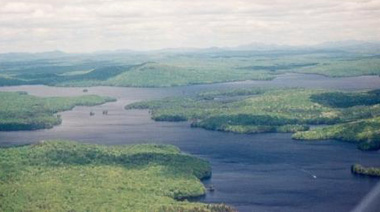Atmospheric Scientist Scott Miller to Study Adirondack Lake for Inland Water Impact on Climate Change
 |
|
Cranberry Lake, where UAlbany atmospheric scientist Scott Miller and ESF biochemist David Kieber will conduct their joint study on the role of inland waters upon carbon dioxide and climate change. |
ALBANY, N.Y. (September 25, 2013) – UAlbany atmospheric scientist Scott Miller is co-principal investigator of a study at the Cranberry Lake Biological Station in the Adirondack Mountains aimed at identifying and quantifying several processes that affect emission of carbon dioxide to the atmosphere and how these can be expected to shift due to climate change.
Slated to begin in the summer of 2014, the research will be done in collaboration with aquatic biogeochemistry David Kieber of SUNY ESF, and is one of seven research projects that will be awarded up to $100,000 from the SUNY Research Collaboration Fund.
Lakes and reservoirs are important sources of carbon dioxide to the atmosphere, with global estimates ranging from 10-15 percent of anthropogenic CO2 emissions. Accurate representation of processes affecting gas exchange is required to understand the role of inland waters in ecosystem, regional, and global carbon cycles and associated impacts of climate change.
Miller and Kieber will incorporate measurements of both physical and biogeochemical processes on the atmospheric and aquatic sides of the air-water interface. Miller, a research associate at UAlbany’s Atmospheric Sciences Research Center, has done extensive work in air-water gas exchange, as has Kieber with water column physical and chemical measurements.
“This is an emerging area of research that is essential for understanding how gas fluxes are coupled to water column biogeochemical processes, and how these may be expected to shift due to climate change,” said Miller.
The SUNY Research Collaboration Fund supports inter-campus research collaborations such as this study. “Collaborative research invites industry interest and entrepreneurial opportunity that leads to innovation, new business, jobs and public benefit. We congratulate each of the fund recipients for their visionary work,” commented Tim Killeen, president of the RF and SUNY’s vice chancellor for research.
There are seven total 2013 SUNY Research Collaboration Fund projects that were selected through a rigorous peer review process. Factors considered in the evaluation included: originality and significance of the research; student involvement; industry and other outreach efforts, and the ability to attract future federal, state, philanthropic or private funding.
![]() For more news, subscribe to UAlbany's RSS headline feeds
For more news, subscribe to UAlbany's RSS headline feeds
A comprehensive public research university, the University at Albany-SUNY offers more than 120 undergraduate majors and minors and 125 master's, doctoral and graduate certificate programs. UAlbany is a leader among all New York State colleges and universities in such diverse fields as atmospheric and environmental sciences, business, education, public health,health sciences, criminal justice, emergency preparedness, engineering and applied sciences, informatics, public administration, social welfare and sociology, taught by an extensive roster of faculty experts. It also offers expanded academic and research opportunities for students through an affiliation with Albany Law School. With a curriculum enhanced by 600 study-abroad opportunities, UAlbany launches great careers.


